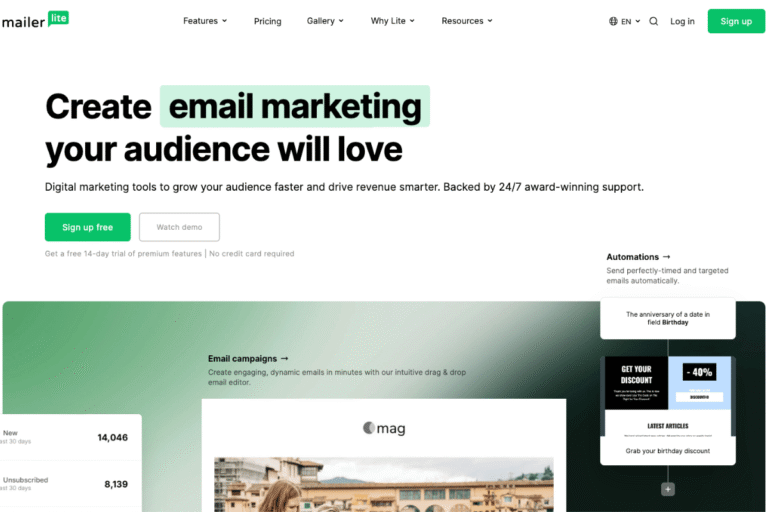If you’ve ever wondered how to create an email marketing campaign that actually wins subscribers, drives clicks, and brings in sales, without burning an entire weekend, this guide is for you. You’ll learn the exact steps I use with small businesses, bloggers, and freelancers to go from zero to send, including tool comparisons (MailerLite, Mailchimp, ConvertKit), deliverability basics, and a simple content plan you can reuse. We’ll cover list building, automation, segmentation, and the metrics that tell you what’s working. By the end, you’ll have a clean, repeatable process, and a ready-to-send campaign you can launch this week.
Define Your Goal And Audience
Pick A Single Campaign Objective (Sales, Leads, Traffic, Or Engagement)
One campaign. One clear objective. That’s the rule. Trying to do everything at once (sell, nurture, survey, announce) usually blurs your message and tanks conversions.
Pick one:
- Sales: Promote a product/service, a seasonal offer, or a limited-time bundle.
- Leads: Grow your list via lead magnets or waitlists.
- Traffic: Send readers to a blog post, YouTube video, or podcast to warm them up.
- Engagement: Re-activate cold subscribers, gather replies, or run a poll.
Write your objective at the top of your brief: “This campaign’s job is to [X] for [audience] by [date].” Keep it visible while you write.
Map Your Ideal Subscriber And Simple Buyer Journey
You’re emailing a person, not a list. Sketch a quick one-paragraph profile:
- Who are they? (e.g., a solo esthetician booking more repeat clients)
- What problem are they trying to solve?
- What would make them feel confident taking the next step?
Then map a 3-step journey:
- Problem-aware: They feel the pain. 2) Solution-aware: They’re comparing options. 3) Decision: They need proof and a clear next step. Your email sequence should escort them through these stages.
Translate Goals Into Measurable KPIs
Turn your objective into 2–4 KPIs so you know if the campaign worked.
- Sales: Revenue, orders, earnings per subscriber (EPS), conversion rate (clicked → purchased).
- Leads: New subscribers, cost per lead (if you’re running ads), confirmation rate (double opt-in).
- Traffic/Engagement: Click-through rate (CTR), time on page, replies.
Add baseline targets. Example for a list of 2,000:
- Open rate: 30–40% (varies by industry)
- CTR: 2–5% on broadcast emails, 5–12% on targeted segments
- Conversion: 1–5% for warm lists on well-aligned offers
These aren’t rules, just starting points. You’ll improve them with testing.
Choose Your Email Service Provider And Set Up Essentials
Compare Core Features Across Popular Tools (MailerLite, Mailchimp, ConvertKit)
Picking your ESP is like choosing a kitchen, you want the tools that fit how you cook. Quick overview:
- MailerLite
- Best for: Beginners, bloggers, small businesses wanting clean design, automations, and great value.
- Pros: Intuitive editor, beautiful landing pages/forms, solid automations, good deliverability for the price.
- Cons: Fewer advanced ecommerce/reporting features than enterprise tools.
- Pricing snapshot: Often offers a free tier for small lists with monthly send caps: paid tiers are competitively priced. Check current pricing.
- Try it: https://www.mailerlite.com/
- Mailchimp
- Best for: All-in-one marketing with templates, basic CRM, and broad integrations.
- Pros: Familiar UI, robust template library, strong ecosystem.
- Cons: Pricing can climb as you scale: some automations and advanced segmentation live on higher tiers.
- Pricing snapshot: Historically includes lower-tier/free options with contact and send limits: verify latest plans.
- Try it: https://www.mailchimp.com/
- ConvertKit
- Best for: Creators, course builders, writers, coaches, needing tagging, simple funnels, and commerce.
- Pros: Creator-first features (visual automations, Commerce), excellent tagging/segmentation.
- Cons: Design templates are simpler: pricing steps up with features/subscribers.
- Pricing snapshot: Often a free plan for basic forms/landing pages, with automations on paid tiers. Confirm current details.
- Try it: https://www.convertkit.com/
Tip: Make a tiny scorecard (1–5) for ease of use, automations, forms/landing pages, deliverability controls, and price at your projected list size in 6–12 months. Choose the winner, not just for today, but for where you’re going.
Authenticate Your Domain: SPF, DKIM, And DMARC
Deliverability isn’t luck: it’s setup. After connecting your domain, add email authentication records at your DNS:
- SPF: Authorizes your ESP to send on your behalf. One SPF record max, combine includes if you use multiple senders.
- DKIM: Cryptographic signature proving the message wasn’t altered.
- DMARC: Tells mailbox providers how to handle failed authentication: start with p=none for monitoring, then move to quarantine/reject gradually.
Most ESPs (MailerLite/Mailchimp/ConvertKit) give exact DNS records. Add them, wait for propagation, and verify inside the ESP. This single step dramatically reduces “spam folder roulette.”
Configure From Name, Reply-To, And Compliance (GDPR, CAN-SPAM)
- From name: Pick a human-friendly format. “Ava at Oak Wellness” tends to outperform a bare brand name.
- Reply-to: Use a monitored inbox. Positive replies help deliverability.
- Compliance basics:
- Always include your physical mailing address in the footer.
- Provide a one-click unsubscribe.
- Collect consent transparently (GDPR). If you serve EU/UK, add a short consent checkbox and link to your privacy policy.
- Keep records of consent. Your ESP usually logs signups automatically.
Do this once and you’re set.
Build And Clean Your Email List
Create High-Converting Forms And Landing Pages
Use your ESP’s form and landing page builder to remove friction. Essentials:
- One clear promise: “Get the 5-step checklist to book 2x more clients this month.”
- Minimal fields: Email + First name. Extra fields crush conversion.
- Social proof: Add a testimonial or subscriber count if you have it.
- Mobile-first: Test the form on your phone: no pinching/zooming.
- Thank-you page: Confirm what happens next and offer a relevant next step.
Offer A Compelling Lead Magnet Or Incentive
People don’t join lists, they join outcomes. Pick one fast win your audience craves:
- Checklists, swipe files, templates
- Short video or mini-course (15–30 minutes)
- Discount or free shipping (ecommerce)
- Private podcast episode or Notion template (creators)
Deliver it instantly after signup. Bonus points for a short onboarding note: “Here’s how to use this in 10 minutes.”
Use Double Opt-In, Tagging, And Ongoing List Hygiene
- Double opt-in: Yes, it slightly lowers confirmations. But it dramatically boosts engagement and reduces spam complaints.
- Tagging: Tag by source (Blog: SEO Checklist, IG: Reels Lead Magnet) and interest (Service A, Service B). You’ll thank yourself later when you segment.
- Hygiene: Every 3–6 months, suppress or remove unengaged contacts (no opens/clicks for 90–120 days). Run a re-engagement email before pruning. This keeps deliverability healthy and costs down.
Plan Your Campaign And Create Your Content
Outline Your Sequence, Cadence, And Timeline
For beginners, keep it simple. A 4–6 email sequence usually covers it:
- Value primer (educational)
- Deeper value + soft pitch
- Social proof + small ask (click to learn more)
- Offer email (clear CTA)
- Objections answered (FAQ style)
- Last-call reminder (if time-bound)
Cadence: 2–3 emails/week for a launch, 1/week for evergreen nurture. Plot dates on a calendar and work backwards from your send date.
Craft A Simple Content Calendar (Value, Soft Pitch, Hard Pitch)
- Value: Teach a single actionable idea. Give them a win right now.
- Soft pitch: Invite readers to learn more, book a call, or view the product, without urgency.
- Hard pitch: Communicate the offer, the transformation, and what happens after they click. If there’s a deadline, state it plainly.
Align Offers, Social Proof, And Objection Handling
List the top 3–5 objections you hear (price, time, fit, tech anxiety). Address one per email. Use:
- Testimonials and case studies
- Before/after snapshots
- Risk reducers (guarantee, trial, sample)
Don’t bury the CTA. If the point is to book a demo, say it clearly and repeat it.
Design And Write Your Emails
Mobile-First Layout, Accessibility, And Brand Consistency
- Single-column layout (600–700px) with generous line spacing.
- Use real text (not image-only emails). Include alt text on images.
- High color contrast for readability: 14–16px body, 18–22px subheads.
- Keep your brand basics consistent: logo lockup, colors, and button style.
Plain-text vs. designed templates? Both work. For sales and promotions, a light template with one hero image and one CTA tends to convert nicely.
Subject Lines, Preheaders, And Hooky First Lines
- Subject lines: Aim for clarity over clever. 35–55 characters. Examples:
- “Your 10-minute SEO checklist (free download)”
- “We opened 3 spots this week, want one?”
- “Quick win: turn one post into 5 emails”
- Preheaders extend the subject (“Opens in Google Docs | No opt-in hoops”).
- First line: Hook fast, promise a result, agitate a pain, or start with a bold stat.
Body Copy Frameworks (PAS, AIDA) And Clear CTAs
Use proven structures:
- PAS (Problem–Agitate–Solve): Name the pain, twist the knife a bit, then present the fix.
- AIDA (Attention–Interest–Desire–Action): Grab attention, build interest with specifics, create desire with outcomes, then invite action.
Copy tips:
- One email, one job. Every paragraph should support the CTA.
- Use scannable formatting: short paragraphs, bullets, subheads.
- Buttons: Action-first labels like “Get the template” or “Book your free consult.” Place a primary CTA near the top and again at the end.
Avoid Spam Triggers And Test Rendering Across Clients
- Avoid spammy phrases (“100% free money…”), deceptive subjects, or all-caps.
- Balance text-to-image: too many images can hurt deliverability.
- Use your ESP’s inbox preview to test dark mode and clients (Gmail, Outlook, Apple Mail). Send yourself a live test and click every link.
- Set up link tracking and verify UTM parameters if you use analytics.
Automate, Segment, And Personalize
Set Up A Welcome Series And Lead Nurture Path
Your welcome series is your highest-leverage automation. Suggested 3–5 emails:
- Deliver the lead magnet + quick start instructions (Day 0)
- Your story and positioning + a small actionable tip (Day 1)
- Case study or social proof + light invite (Day 3)
- Value tutorial that naturally transitions to your offer (Day 5)
- Offer email with a clear CTA (Day 7)
Keep it evergreen. Update quarterly with fresh proof or FAQs.
Use Tags, Segments, And Simple Behavior Triggers
- Tags: Mark interests, product lines, or content consumed. Example: Tag “Ecom–Skincare” vs. “Service–Web Design.”
- Segments: Build dynamic groups (e.g., “Clicked Offer A but didn’t purchase”).
- Triggers: If clicked a product link → send a comparison email: if didn’t click for 30 days → send re-engagement. MailerLite, Mailchimp, and ConvertKit all support these in different flavors, start simple.
Personalize With Merge Fields And Dynamic Content
- Merge fields: First name, company, or location can boost response when used sparingly. Lead with value: the name is the seasoning, not the soup.
- Dynamic blocks: Swap testimonials, images, or offers based on tags/segments. Example: Show creator-focused proof to creators and local-service proof to brick-and-mortar.
Personalization should reduce friction, not feel creepy. Don’t over-collect data you won’t use.
Test, Send, And Measure
Run Smart A/B Tests (Subject, Offer, CTA, Timing)
Test one variable at a time:
- Subject lines: Curiosity vs. clarity.
- Offer framing: “20% off” vs. “Save $40 today.”
- CTA copy: “Start free trial” vs. “Try it free for 14 days.”
- Send time/day: Your audience might prefer Sundays. Only data knows.
For lists under ~5,000, test big swings (very different subject lines) to see clear winners. For larger lists, you can test nuanced differences.
Pre-Send Checklist: Links, Alt Text, Tracking, Plain-Text
- Click every link (including the logo). Fix typos.
- Add alt text to images and a web-view link if available.
- Confirm Google Analytics UTMs (source= email, medium= newsletter, campaign= [name]).
- Include a simple plain-text version: some clients prefer it and it helps deliverability.
- Preview on mobile and dark mode.
Track Opens, Clicks, Conversions, And Deliverability
- Opens: After privacy changes, opens are directional at best, use them for trendlines, not exact truth.
- Clicks: Your best high-intent engagement signal.
- Conversions: Tie to your store, checkout, booking, or lead forms. Use your ESP’s ecommerce tracking or connect via your CRM/analytics.
- Deliverability: Watch bounce rate (<2% is healthy), spam complaints (<0.1%), and inbox placement (ESP seed tests can help).
Diagnose And Optimize: Low Opens, Low CTR, Spam Complaints
- Low opens: Tighten your subject/preheader, resend to non-openers 48–72 hours later with a new subject, and prune unengaged segments.
- Low CTR: Reduce distractions. One CTA. Make buttons bigger. Align the email promise with the landing page payoff.
- High complaints: Re-check consent sources, simplify unsubscribes, and avoid surprise content. Consider a re-permission campaign for older contacts.
Small tweaks compound. Document what you tested and the outcome so each campaign gets smarter.
Conclusion
You now have a complete, beginner-friendly system for how to create an email marketing campaign, from defining a single goal to writing persuasive emails, automating follow-ups, and measuring what matters. Start small: pick one clear objective, set up your ESP properly (authentication is non-negotiable), build your list with a valuable lead magnet, and ship a simple 4–6 email sequence.
Ready to try a tool today? Here are solid starting points:
- MailerLite: Clean design, great value. Start free: https://www.mailerlite.com/
- Mailchimp: Familiar and flexible for many stacks: https://www.mailchimp.com/
- ConvertKit: Creator-friendly automations and commerce: https://www.convertkit.com/
Quick action plan for this week:
- Choose your ESP and authenticate your domain.
- Create one landing page + lead magnet.
- Write a 3-email welcome series.
- Send your first value email with one CTA.
Disclosure: Some links above may be affiliate links, at no extra cost to you. If you choose to use them, thank you. Now go hit send, your best subscribers are waiting.
Frequently Asked Questions
What’s the first step in how to create an email marketing campaign?
Start by choosing one clear objective (sales, leads, traffic, or engagement). Define your ideal subscriber and map a simple three-step journey (problem-aware, solution-aware, decision). Translate the goal into 2–4 KPIs with baselines—e.g., 30–40% opens, 2–5% CTR, 1–5% conversion for warm lists.
Which ESP should I use for a beginner email marketing campaign?
MailerLite is great value for clean design and easy automations. Mailchimp offers broad integrations and a robust template library. ConvertKit excels for creators with tagging and simple funnels. Score each on ease, automations, forms, deliverability controls, and price at your projected list size, then pick for where you’re going.
How do SPF, DKIM, and DMARC improve deliverability?
They authenticate your domain so inbox providers trust your messages. Add SPF to authorize your sender, DKIM to sign emails cryptographically, and DMARC to instruct how to handle failures (start with p=none, then tighten). Set records in your DNS, wait for propagation, and verify inside your ESP.
How to create an email marketing campaign sequence for beginners?
Use a simple 4–6 email sequence: value primer, deeper value + soft pitch, social proof + small ask, core offer, objection handling, and a last-call reminder if time-bound. Send 2–3 times weekly for launches or weekly for evergreen. Keep one clear CTA per email and align with your goal.
When is the best time to send marketing emails?
There’s no universal best time; audience and niche matter most. Many lists see solid performance midweek, mid‑morning or early afternoon, but validate with A/B tests. Test big swings first (weekday vs. weekend, morning vs. evening), segment by behavior, and use ESP send‑time optimization if available.
How long should a marketing email be, and how many CTAs?
Keep it scannable with short paragraphs and one job per email. For promotions, 75–200 words plus one clear primary CTA works well. Educational emails can run 300–500 words if tightly structured. Place the main CTA near the top and again at the end; avoid multiple competing buttons.


